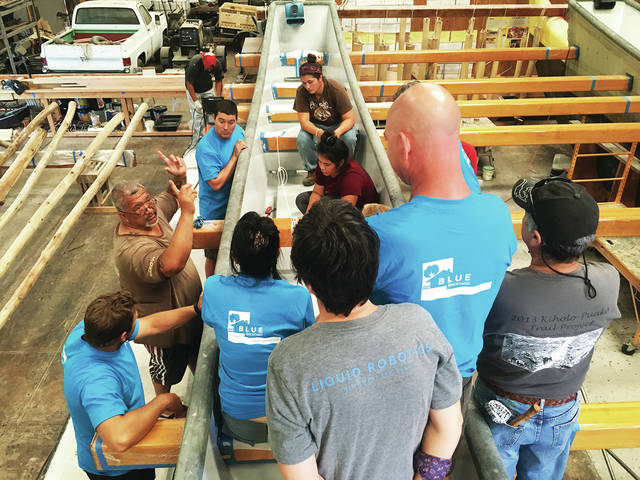Out to sea: Liquid Robotics uses Wave Gliders to restore the island’s ocean and coastal communities
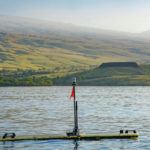
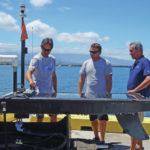
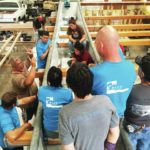
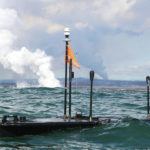
KAWAIHAE — In the heart of the Kawaihae Harbor is a homegrown company called Liquid Robotics.
The internationally known entity invented and manufactures the Wave Glider — the world’s first wave- and solar-powered, autonomous, unmanned, marine robot.
From humble beginnings, including an early prototype made from a surfboard purchased at Costco in Kona, the latest in the Wave Glider fleet is the SV3, a sleek ocean-faring vehicle with two main parts: a float that sits on the surface of the ocean, and a sub with wings that hangs by an umbilical cord anywhere from 8 to 20 feet below.
Wave power pushes up and down on the wings to propel the Wave Glider, while its onboard computing and sensor infrastructure is powered by solar panels.
“Descriptively, that’s the secret sauce of the SV3 — it requires no fuel and all the onboard electronics are solar powered,” Liquid Robotics Hawaii’s operations manager Tony San Jose said.
Wave Gliders operate as totally “clean” technology: they’re quiet, don’t pollute and cause no harmful effects to the environment or marine life.
With its relatively simple design, the Wave Glider is making big waves, revolutionizing how governments, businesses and academic consortiums explore and understand the world’s oceans.
When deploying its Wave Glider for the first time, a recent pleased customer — East Carolina University — was so impressed they called it “a dream machine for all of us.”
Hawaii operations
The Liquid Robotics Marine Operations facility in Kawaihae is used for testing, prototyping and customer training, while actual Wave Gliders are manufactured and assembled in the company’s headquarters in Sunnyvale, California.
On a recent blue sky day in Kawaihae, looking out at a crystal clear ocean, it was easy for San Jose to point out why the facility is an ideal location for testing the Wave Glider.
“We have access to beautiful water here and the Coast Guard designates clear access operating areas for us,” he said.
Challenging conditions are available, too.
“We can always put the Wave Glider out in the Alenuihaha channel if we want to test in tougher sea states,” San Jose added.
Lani Kamauu Yamasaki, who created and facilitates the company’s community outreach and development program is equally excited about Liquid Robotics’ roots and location in Kawaihae, as a lineal descendant with deep ancestral ties to Mailekini Heiau and Pu’ukohola Heiau. West Hawaii is steeped in rich Hawaiian culture and history.
“We’re located on the corridor of the Ala Kahakai National Historic Trail and National Park, whose vision is creating self-sufficiency through the aina,” she said.
The company’s environmentally friendly footprint, therefore, is one reason why she feels Liquid Robotics has been embraced by the Hawaiian community.
“We have been embraced as a modern navigator by our wa’a community and that’s why we have such strong partnerships with Makali’i/Na Kalai Wa’a and “Promise to Pae’aina,” which includes the Hokulea. It’s our kuleana to be a responsible community partner,” Yamasaki said.
A Boeing Company
In December 2016, Liquid Robotics became a wholly owned subsidiary of Boeing. Their new parent company fully supports giving back to the community, especially on the Big Island where the Wave Glider was born.
As part of that philosophy, the company encourages education in the marine sciences and robotics fields to get kids interested in these new fields.
“A huge part of our outreach is helping to ensure we nurture and keep local talent here,” Yamasaki said.
Together with its community partners, Liquid Robotics is working to restore the health of the island’s ocean and coastal communities. Wave gliders are providing scientific weather and water quality data to natural resources managers statewide to help them make informed decisions about matters impacting the health and future of island lands and communities.
In addition, Wave Glider data is archived by NOAA for use by resource managers. Critical data provided by Wave Gliders for NOAA’s West Hawaii Habitat Blueprint includes substantiating cesspool seepage into Puako Bay. The data is also contributing to a community-based marine planning project for Maunalua Bay, and the “Promise to Pae’aina” water quality database.
Community outreach
By request, Liquid Robotics created a permanent Wave Glider exhibit for the Mokupapapa Discovery Center and UNESCO World Heritage Site in downtown Hilo, and Papahanaumokuakea Marine National Monument. As part of a larger, voyaging themed exhibit, the interactive exhibit emphasizes high technology tools instrumental in the advance of ocean science.
Liquid Robotics employees have also supported local STEAM initiatives and worked with local schools to develop STEAM based curricula.
The company co-sponsors Na Kilo ‘Aina, a community day co-organized by Kailapa Community Association and Sea Grant, at their facility every October, and Liquid Robotics Hawaii staff regularly serve as judges and advisers for various Hawaii Island robotics and remotely operated vehicle competitions.
As a private company, they also work with community groups including nonprofits such as The Nature Conservancy; federal entities like the National Park Service and NOAA; academics including the University of Hawaii; and local grassroots support groups including Puako and Kailapa Community Associations and the South Kohala Conservation Action Plan.
“We have more than 18 partners coming together to malama aina and care for our corridor here, working together toward self-sufficiency,” Yamasaki noted.
Data collection at Kilauea
With the recent Kilauea volcano disaster occurring in the place they call home, Liquid Robotics Hawaii staff wanted to help.
Led by Senior Field Engineers Chuck Shaver and Billy Middleton, in conjunction with the Massachusetts Institute of Technology, Scripps, USGS and the University of Hawaii at Hilo, two SV3 Wave Gliders were deployed from Kawaihae to Kilauea in June and July, one swimming south all around the island and the other going north.
The Kilauea project was remarkable because previously, very little data had even been collected from the ocean during a live volcano event due to the extreme danger.
The Wave Gliders operated for six weeks in different modes to collect data on water conditions, air quality and underwater acoustics. They provided a rare opportunity for scientists to measure the impact of a live lava flow on water temperatures, coral reefs, fish populations and other marine life.
Additionally, measuring the laze — or lava haze — from the ocean will provide insights going forward on air quality and patterns caused by the hazardous toxic fumes.
It started with a whale call
The Wave Glider originally came from a desire by one of the company’s founders, Joe Rizzi, to hear sounds of the humpback whale in his living room in Puako.
From a crude prototype using a surfboard and acoustics, Rizzi and his friend Derek Hine looked to Hine’s son, Roger, to design a more sophisticated product, which he did, resulting in the Wave Glider SV2.
With a succession of improvements and variations, today’s Wave Glider SV3 is a marvel of engineering for both its simplicity and ocean accessibility. Giving governments and businesses worldwide the ability to collect data from the ocean harkens back to the whale call that started it all.
“The whale is one our aumakua (family guardians), and worldwide the whale signifies storytelling and passing of tradition for many traditional peoples,” Yamasaki said. “It’s all about sharing knowledge and culture, making sure the next generation is able to thrive.”



